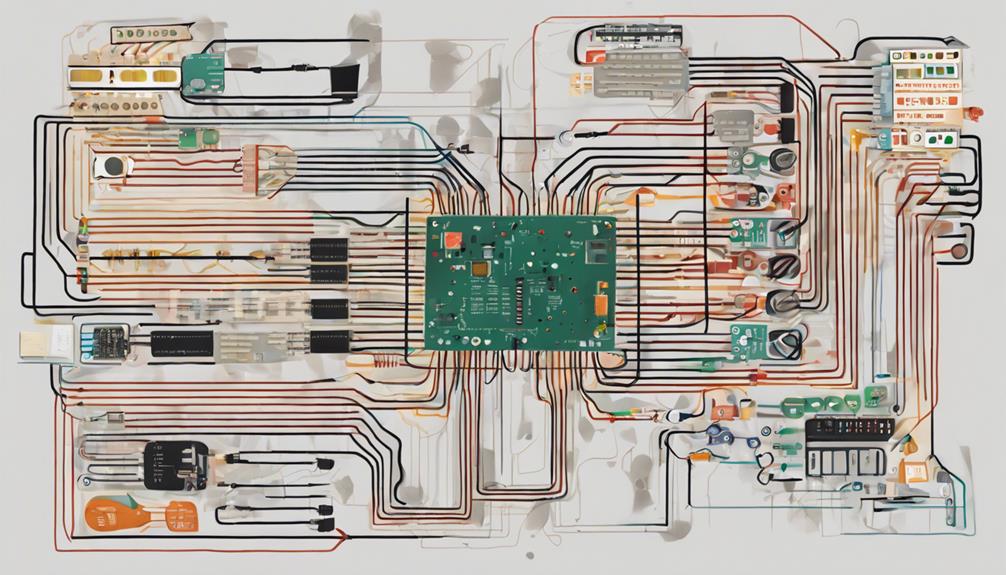Design for Testability (DFT) is a critical engineering discipline that facilitates efficient fault detection and isolation in printed circuit boards (PCBs). Effective DFT involves strategic considerations for testing processes, placing test points effectively, and adhering to clearance requirements. It also involves selecting the right testing method, such as ICT or flying probe, and following best practices for DFM and DFT. By adhering to essential guidelines and rules, designers can guarantee thorough test coverage, fault isolation, and reduced manufacturing errors and costs. As we explore the intricacies of DFT, the importance of careful planning and execution becomes increasingly evident, revealing the nuances of this complex discipline.
Key Takeaways
- Adhere to fundamental DFT rules for test point design to ensure efficient fault detection and isolation.
- Ensure minimum 50 mil clearance to components and traces, and 100 mil clearance to the board's edge for test points.
- Design net-specific test points for thorough testing, and coordinate for simultaneous ICT testing on both PCB sides.
- Proper placement of test points impacts test coverage and signal integrity, ensuring critical nodes and signals are accessible for testing.
- DFT enables efficient fault detection and isolation, reducing manufacturing errors and costs, and facilitating accurate fault diagnosis.
PCB Testability Design Guidelines
Optimizing the design layout for efficient testing processes, PCB testability guidelines provide a set of strategic considerations for guaranteeing thorough testing coverage and cost-effective manufacturing. These guidelines, essential for design for testability, focus on strategically placing test points, considering clearance requirements, and adhering to contract manufacturer (CM) recommendations. By following these guidelines, designers can make sure that test points on the printed circuit board (PCB) are easily accessible, facilitating thorough test coverage and fault isolation.
Effective PCB design for testability involves placing test points in locations that enable efficient testing using various test methods. This ensures that the testing process is streamlined, reducing the overall production time and cost. Moreover, adhering to testability guidelines leads to enhanced product quality, reduced rework, and accelerated time-to-market for PCB assemblies. By incorporating these guidelines into the design process, designers can create a robust and reliable PCB design that meets the demands of modern manufacturing.
ICT Test and Flying Probe

In the field of printed circuit board (PCB) testing, two prominent methods have emerged: In-Circuit Test (ICT) and Flying Probe, each catering to distinct production volumes and requirements.
ICT testing is ideal for high-volume production, offering high-throughput capabilities and thorough testing coverage. It can detect faults like shorts, missing components, and wrong placements. ICT systems require fixture development based on complexity, which can be time-consuming. However, they can apply power to test analog/digital circuits for functionality.
Flying probe testing, on the other hand, is suitable for prototypes and low-volume production due to its flexibility in testing various board sizes. It has minimal fixture requirements, making it a cost-effective option. Although slower than ICT testing, flying probe testing is an efficient method for small to medium-sized production runs.
| Method | Production Volume | Fixture Requirements |
|---|---|---|
| ICT | High-volume | Complex fixture development |
| Flying Probe | Low-volume/Prototypes | Minimal fixture requirements |
| ICT | High-throughput testing | Thorough testing coverage |
When designing for testability (DFT), it is essential to take into account the production volume and requirements. By following DFT guidelines, contract manufacturers (CMs) can ensure effective testing and reduce production costs. Test points must be carefully planned to accommodate the chosen testing method, ensuring seamless integration and efficient testing processes.
DFM and DFT Best Practices

Contract manufacturers play an important role in ensuring testability by providing DFM and DFT guidelines. These guidelines, when followed, facilitate efficient testing processes and reduce production costs. They are essential for the best design and testing of printed circuit boards (PCBs).
By reviewing the contract manufacturer's guidelines, manufacturers can assess their expertise and capability in guaranteeing testability. DFT guidelines are essential for initial layout planning to facilitate efficient testing processes. It is vital to discuss specific test point requirements with knowledgeable test engineers for thorough test coverage.
Implementing DFT best practices aids in selecting the best contract manufacturer for successful product manufacturing. A well-designed circuit with sufficient test pads and easily accessible solder joints enables efficient testing and reduces the need for costly rework. Visual inspection is also facilitated, ensuring that defects are identified early in the production process.
PCB Design for Testability

By strategically integrating test points into the layout, PCB Design for Testability (DFT) enables efficient fault detection and isolation during testing, thereby reducing manufacturing errors and costs. This approach guarantees that test probes can access critical nodes and signals, facilitating accurate fault detection and diagnosis.
Proper placement of test points is essential, as it directly impacts test coverage and signal integrity. Well-designed test points enable efficient testing, reducing the likelihood of manufacturing errors and associated costs.
In PCB design, DFT principles guide the placement of test points to optimize test coverage, ensuring that all critical components and signals are accessible for testing. This holistic approach to testability enables the detection of faults early in the manufacturing process, reducing the likelihood of defects and associated costs.
Essential DFT Rules and Considerations

To guarantee effective testing and fault detection, designers must adhere to a set of fundamental DFT rules and considerations that guide the placement and design of test points. In designing for testability, it is essential to make sure that test points have a minimum 50 mil clearance to components and traces for proper access.
Additionally, test points should have a 100 mil clearance to the board's edge for ease of testing. Coordination with the contract manufacturer (CM) allows for simultaneous ICT testing on both sides of the PCB, facilitating thorough test coverage during manufacturing.
Design net-specific test points are vital for thorough testing, enabling the detection of open circuits and faults in the electrical connections. Easily accessible probe points for manual testing aid technicians in efficient fault isolation, reducing downtime and increasing overall production efficiency.
Frequently Asked Questions
What Are the Principles of Design for Testability?
The principles of Design for Testability (DFT) revolve around incorporating test points, access, and visibility to facilitate efficient testing.
Key principles include providing clear signal paths, controlled impedance, and adequate power and ground connections.
Additionally, test points should be kept clear of components, with sufficient spacing for test probes, and signal integrity guaranteed.
What Are DFT Guidelines?
DFT guidelines are a set of rules and recommendations that facilitate the design of Printed Circuit Boards (PCBs) with testability in mind. These guidelines outline specific requirements for test points, trace considerations, and testing methodologies to guarantee efficient fault isolation and quick testing.
What Are PCB Guidelines in Testing?
In a recent project, a leading electronics manufacturer implemented PCB guidelines to guarantee efficient testing of their new product line.
For instance, they incorporated test points with a minimum clearance of 0.5 mm to facilitate flying-probe testing. By doing so, they achieved a 30% reduction in testing time and a 25% increase in fault detection accuracy.
PCB guidelines in testing focus on incorporating test points, traces, LEDs, and specific circuit features to secure operational and functional testing accuracy and fault identification.
What Are the Approaches in Design for Testability?
In the domain of design for testability, several approaches facilitate efficient testing and fault detection. Key strategies include creating test points for easy access, implementing boundary scan testing, and utilizing JTAG devices to enhance fault detection capabilities.
Additionally, incorporating built-in self-test features and designing for easy debug and fault isolation are essential in achieving testability goals. These approaches enable effective testing, reducing time-to-market and improving overall product reliability.


